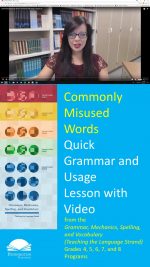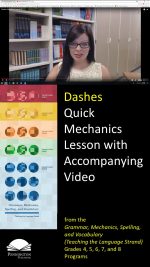Non-standard English Misused Words
Non-standard English Misused Words
Play the quick video lesson HERE and click the upper left back arrow to return to this lesson.
Common Core Language Standard 1
Sometimes we hear an incorrect word or phrase so often that it sounds correct. Learning to pay attention to those commonly misused words and phrases will help you use them correctly in your speaking and writing.
Today’s grammar and usage lesson is on Non-standard English Commonly Misused Words. Remember that Non-standard English often differs from Standard English because of regional or cultural dialects. Often we are used to hearing and saying words that are not Standard English.
Now let’s read the grammar and usage lesson and study the examples.
Following are commonly misused words:
- Farther refers to a physical distance. Example: How much farther is the next restaurant? Further refers to a degree or more time. Example: Further your knowledge by reading.
- Beside means “next to.” Examples: She sits beside me. Besides means “except” or “furthermore.” Example: No one is having fun besides him. I am tired, besides I am sick.
- Less deals with an amount, but can’t be counted. Example: I want less food. Fewer deals with an amount you can count. Example: I want fewer apples, not more.
- Disinterested describes a person who is neutral, fair, and impartial. Example: The disinterested referee made the call. Uninterested describes a person who is not interested. Example: The uninterested girl paid no attention to the flirtatious boy.
- Allowed means permitted. Example: Parking is allowed on this street. Aloud means heard by others. Example: He spoke aloud to the class.
Now circle or highlight what is right and revise what is wrong according to grammar and usage lesson.
Practice: I’m really disinterested about the season. I am watching less games than ever. Plus, the stadium is further than I want to go and tailgating isn’t aloud. And I have to sit beside a stranger.
Let’s check the Practice Answers.
Mechanics Practice Answers: I’m really disinterested about the season. I am watching fewer games than ever. Plus, the stadium is farther than I want to go and tailgating isn’t allowed. And I have to sit beside a stranger.
Now let’s apply what we have learned.
Writing Application: Write your own sentence using a non-standard English Commonly Misused Words. Then write a second sentence correcting that non-standard English.
*****

Pennington Publishing Grammar Programs
Teaching Grammar, Usage, and Mechanics (Grades 4, 5, 6, 7, 8, and High School) are full-year, traditional, grade-level grammar, usage, and mechanics programs with plenty of remedial practice to help students catch up while they keep up with grade-level standards. Twice-per-week, 30-minute, no prep lessons in print or interactive Google slides with a fun secret agent theme. Simple sentence diagrams, mentor texts, video lessons, sentence dictations. Plenty of practice in the writing context. Includes biweekly tests and a final exam.
Grammar, Usage, and Mechanics Interactive Notebook (Grades 4‒8) is a full-year, no prep interactive notebook without all the mess. Twice-per-week, 30-minute, no prep grammar, usage, and mechanics lessons, formatted in Cornell Notes with cartoon response, writing application, 3D graphic organizers (easy cut and paste foldables), and great resource links. No need to create a teacher INB for student make-up work—it’s done for you! Plus, get remedial worksheets, biweekly tests, and a final exam.
Syntax in Reading and Writing is a function-based, sentence level syntax program, designed to build reading comprehension and increase writing sophistication. The 18 parts of speech, phrases, and clauses lessons are each leveled from basic (elementary) to advanced (middle and high school) and feature 5 lesson components (10–15 minutes each): 1. Learn It! 2. Identify It! 3. Explain It! (analysis of challenging sentences) 4. Revise It! (kernel sentences, sentence expansion, syntactic manipulation) 5. Create It! (Short writing application with the syntactic focus in different genre).
Get the Diagnostic Grammar, Usage, and Mechanics Assessments, Matrix, and Final Exam FREE Resource:
![]()







